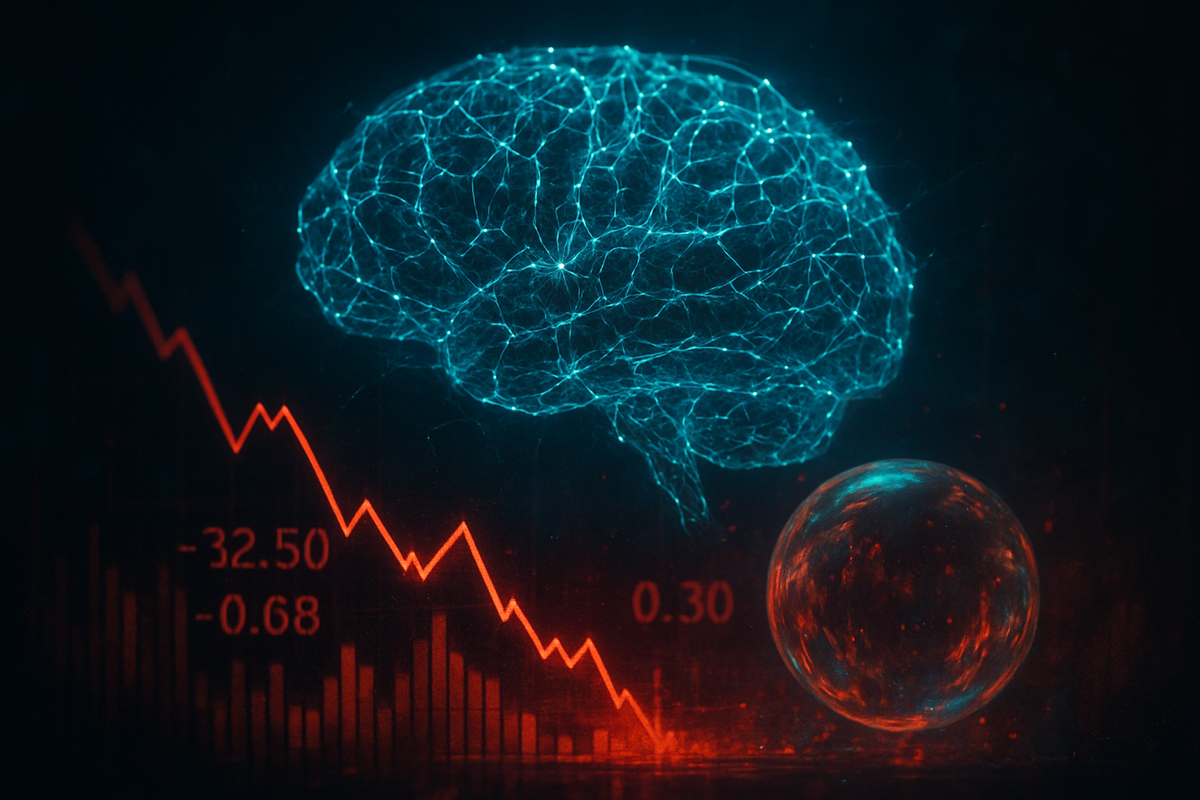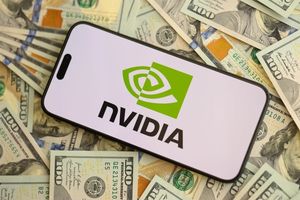
As November 2025 unfolds, a palpable sense of apprehension grips global financial markets, fueled by mounting investor concerns over a potential Artificial Intelligence (AI)-driven market bubble. The once-unbridled enthusiasm surrounding AI innovation is now tempered by a critical reassessment of sustainability, leading to increased volatility and a noticeable shift in investment sentiment. This growing unease is rooted in increasingly stretched valuations, the speculative nature of many AI investments, and the immediate implications for overall market stability, prompting a significant capital rotation towards more traditional sectors.
The current environment is characterized by a tension between the undeniable long-term transformative potential of AI and the immediate, pressing concerns over the financial metrics of companies operating within this sphere. Analysts and institutional investors are openly debating whether the AI boom mirrors past speculative frenzies, with a significant portion believing a bubble is indeed forming. This dynamic is forcing market participants to re-evaluate their risk appetite and adapt their investment strategies to navigate what could be a pivotal period for the global economy.
Unpacking the AI Speculation: Exorbitant Valuations and Shifting Realities
The current market landscape, as of November 2025, reveals several alarming indicators contributing to the growing belief in an AI-driven bubble. Exorbitant valuations are perhaps the most striking feature, with many AI-centric companies trading at multiples that defy conventional financial analysis. For instance, Palantir Technologies (NYSE: PLTR) has been observed trading at over 700 times forward earnings, while industry giants like Nvidia (NASDAQ: NVDA) and Advanced Micro Devices (NASDAQ: AMD) boast price-to-earnings (P/E) ratios exceeding 50 and 45 respectively. Even AI startups are frequently valued at 30-50 times their revenue, a stark contrast to the typical 5-10 times for traditional Software-as-a-Service (SaaS) companies.
This valuation inflation is often attributed to a significant disconnect between the hyped potential of AI and its proven, measurable profitability. While companies like OpenAI generated substantial revenue in the first half of 2025, they simultaneously reported significant losses, indicating a challenging path to sustainable profitability. An August MIT report further highlighted this disparity, finding that 95% of corporations adopting Generative AI programs had yet to deliver measurable financial value. This environment is reminiscent of past technology bubbles, characterized by uncertainty over ultimate end-use, a focus on "pure play" companies, and a reliance on compelling narratives rather than robust fundamentals. The market capitalization is also unprecedentedly concentrated in a few dominant AI players, with Nvidia, for example, reaching a $5 trillion valuation in early November 2025, representing a significant portion of the S&P 500 index – a concentration that raises systemic risk concerns.
The speculative nature of AI investments is further underscored by practices such as "circular revenue loops" and "vendor-financed deals." These arrangements, where funds flow between partners (e.g., cloud providers, chipmakers, and AI developers) in ways that can artificially inflate demand or valuations, are becoming increasingly common. For instance, Nvidia has faced accusations of engineering demand by investing in firms that subsequently purchase its chips. Despite massive investments, The Economist has noted almost zero economic productivity growth from AI in the US, and Gartner predicts that over 40% of agentic AI projects will be abandoned by the end of 2027. While proponents argue that today's AI companies are more profitable than dot-com era startups, critics contend that these profits often derive from existing business lines rather than the nascent, often cash-burning, generative AI products themselves. This blend of stretched valuations, speculative financing, and a gap between hype and tangible economic impact has already translated into increased market volatility, significant sell-offs in tech-heavy indexes, and a clear "risk-off" movement, prompting a notable rotation of capital away from high-flying technology stocks.
Winners and Losers in the AI Crucible: Navigating a Volatile Landscape
The specter of an AI-driven market bubble casts a long shadow, delineating a clear divide between companies poised for continued triumph and those facing significant headwinds or even substantial losses. As of November 2025, experts are drawing parallels to the dot-com bubble, highlighting concerns over rapid valuation increases driven by speculation rather than proven profitability, especially among early-stage ventures. The concentration of market value in a few "Magnificent Seven" tech giants further intensifies systemic risk, suggesting that corrections in these bellwethers could trigger broader market impacts.
Companies positioned to win or demonstrate resilience in this environment generally fall into categories that provide essential AI infrastructure, possess robust business models integrating AI, or demonstrate clear, monetizable AI capabilities. At the forefront are AI Infrastructure Providers, often dubbed the "shovel sellers" of the AI gold rush. These include semiconductor powerhouses like NVIDIA (NASDAQ: NVDA), the dominant supplier of GPUs crucial for AI model training and inferencing, whose market value surged to $5 trillion in early November 2025. While its valuation is high, its foundational role makes it a strong contender for long-term growth, even if a bubble burst leads to a significant stock price correction. Similarly, Broadcom (NASDAQ: AVGO), a key player in AI accelerators and data center networking, and Taiwan Semiconductor Manufacturing Company (NYSE: TSM), the indispensable contract chip manufacturer for advanced AI chips, are well-positioned. Memory chip producer Micron Technology (NASDAQ: MU), with its critical High-Bandwidth Memory (HBM) for AI workloads, is also seeing significant revenue spikes. The major Cloud Computing Giants – Microsoft (NASDAQ: MSFT) (Azure), Alphabet (NASDAQ: GOOGL) (Google Cloud), and Amazon (NASDAQ: AMZN) (AWS) – are also robust contenders, providing the scalable computing power, storage, and specialized AI services essential for AI development. Their diversified business models and integration of AI across vast product ecosystems provide significant resilience. Companies like Dell Technologies (NYSE: DELL) and Super Micro Computer (NASDAQ: SMCI), providing servers and cooling solutions for AI data centers, also stand to benefit from the foundational demand.
Conversely, companies most vulnerable to an AI bubble burst are often those with valuations heavily inflated by hype, lacking a solid underlying business model, clear profitability, or sufficient differentiation. This category largely includes Overvalued "AI Pure-Plays" and Early-Stage Ventures that have yet to demonstrate scalable revenue generation or a clear path to profitability. OpenAI, despite its pivotal role in generative AI, faces scrutiny over its massive cash burn ($14 billion annually) and substantial investment commitments, raising questions about its long-term financial viability if revenue projections don't materialize. CoreWeave, a GPU-native cloud provider, faces significant risk if major clients like OpenAI stumble, potentially leading to substantial revenue losses. Palantir Technologies (NYSE: PLTR), while a leader in AI-driven data analytics, has been targeted by short-sellers due to its extremely high valuation (upwards of 200 times forward earnings), making it susceptible to sharp corrections if market sentiment shifts. Furthermore, companies that rush to implement AI without a clear strategy for value creation, or those whose existing business models are threatened by rapid AI advancements without the ability to adapt, could face long-term decline. The interconnected web of investments and partnerships among major AI players also means that the failure or underperformance of one key company could trigger a "devastating chain reaction" across the market, reminiscent of the 2008 financial crisis. Ultimately, resilience in an AI bubble scenario will likely come from diversified business models, proven profitability, and a clear, well-executed strategy for integrating and monetizing AI, rather than simply investing heavily in the technology.
The Wider Significance: Echoes of History and a Shifting Economic Paradigm
The potential for an AI-driven market bubble carries profound wider implications, resonating across industries, regulatory frameworks, and global financial systems, drawing both unsettling parallels and critical distinctions from historical economic events. As of November 2025, the market is navigating a complex landscape where genuine technological breakthroughs intersect with speculative fervor, creating an environment ripe with both opportunity and significant risk.
A defining characteristic of the current AI boom is an unprecedented and sustained investment in AI infrastructure, encompassing chips, accelerators, and data centers. This "capex supercycle" sees tech giants pouring hundreds of billions into building the foundational architecture for AI, with global AI infrastructure spending projected to soar. This trend is fostering a strategic shift from reliance on generic cloud services to more specialized, in-house AI infrastructure investments, particularly for cost-effective inference solutions. While the investment is staggering, a significant "GenAI Divide" has emerged, revealing that a large majority (95%) of organizations investing in generative AI are currently seeing zero return, with only 5% extracting substantial value. This highlights a critical disconnect between the adoption of generic tools and the successful integration of custom AI solutions that yield measurable business impact, though the rise of agentic AI is expected to bridge this gap, driving efficiency across various sectors.
A potential market correction or bubble burst would unleash profound ripple effects. Competitors and partners heavily reliant on leading AI providers or deeply embedded in the AI supply chain could face significant disruptions. Smaller AI startups, in particular, would likely encounter heightened scrutiny and reduced access to capital, inevitably leading to consolidation as larger, more established tech firms acquire struggling ventures at discounted valuations. The current market concentration, with a few dominant AI players like NVIDIA (NASDAQ: NVDA) representing a substantial portion of the S&P 500, poses systemic risks; a downturn in these giants could have broad market repercussions. Beyond the tech sector, the entertainment content industry is already grappling with AI's ability to democratize content creation, impacting traditional media companies. The insatiable demand for computational power from AI is also profoundly affecting commodity markets, particularly energy, with projections indicating a massive surge in global power demand from data centers, necessitating vast investments in new generation capacity and infrastructure, thereby boosting demand for natural gas, uranium, and even coal.
The rapid growth and potential volatility of the AI market are also bringing significant regulatory and policy implications to the forefront. Governments worldwide are intensifying scrutiny and oversight, with central banks monitoring AI investment for potential systemic risks, leading to discussions about antitrust investigations and changes in securities regulations. Beyond financial stability, profound ethical and societal concerns surrounding data privacy, the ethical deployment of AI, potential job displacement, and the concentration of power among a few dominant AI developers are driving calls for stringent rules or liability regimes, which could raise compliance costs and slow deployment. Some analysts even suggest that deregulation has contributed to the current AI bubble, advocating for policies that ensure safety and governance to temper unsustainable market valuations.
Historically, the current AI market is frequently compared to the dot-com bubble of the late 1990s and, by some, even the 2008 financial crisis. Similarities to the dot-com era include extreme valuations fundamentally disconnected from revenue generation, speculative growth driven by transformative technology narratives, and a focus on growth metrics over cash flow. The unprecedented market concentration in a few "Magnificent Seven" companies echoes, and in some ways surpasses, the concentration seen during the dot-com boom. Concerns about high corporate debt taken on to fund AI infrastructure also draw parallels to trends preceding the 2008 crisis, with figures like Michael Burry, known for predicting the 2008 meltdown, placing substantial short bets against AI giants. However, crucial differences exist: current AI investment sees significant institutional participation rather than primarily retail speculation, and proponents argue that today's AI technologies demonstrate actual functional capabilities and integration into existing business infrastructure, unlike many purely speculative internet companies of the late 1990s. Federal Reserve Chair Jerome Powell has also noted that AI corporations are generating large revenues, distinguishing it from past tech bubbles. Despite these counterarguments, the extreme valuations, market concentration, and speculative nature of certain AI investments suggest that the market stands at a critical juncture, where a potential correction could lead to widespread ripple effects and increased calls for regulatory intervention.
The Road Ahead: Navigating AI's Opportunities and Perils
The trajectory of the AI market, currently soaring amidst both genuine innovation and speculative froth, presents a complex landscape of short-term volatility and long-term transformative potential. As of late 2025, the market stands at a critical juncture where strategic pivots, diligent risk management, and a keen eye for genuine value will determine success for both companies and investors.
In the short term (late 2025 - early 2026), AI is poised to become the "operating system of business," transitioning from niche applications to ubiquitous integration across diverse industries. The rise of "agentic AI," where systems move beyond assistance to autonomous, multi-step actions, promises significant advancements in efficiency and automation, from customer service to predictive data analysis. However, this period is also expected to be characterized by continued market volatility in AI stocks, fueled by uncertainties surrounding the returns on massive AI investments and evolving regulatory frameworks. Looking further ahead (next 5-10 years), the long-term outlook remains largely optimistic. The global AI market is projected for sustained, significant expansion, transforming sectors like healthcare, manufacturing, finance, and transportation. Autonomous systems are expected to mature, and McKinsey research estimates a long-term AI opportunity of $4.4 trillion in added productivity growth potential. This will undoubtedly redefine work, automating tasks while creating new roles demanding uniquely human skills.
For companies, strategic adaptation is paramount. This includes making calculated decisions on aggressive AI investment versus maintaining resilient business models with strong cash flows. Some firms are already making significant pivots into AI infrastructure, like Iris Energy Ltd. (NASDAQ: IREN) shifting to AI data centers. Investing in workforce development, establishing clear AI policies, and prioritizing ethical AI development are crucial for managing risks and fostering trust. Critically, companies must ensure their massive capital expenditures on AI infrastructure translate into tangible returns, not just speculative growth.
For investors, navigating this environment requires robust risk management. Diversification is key, reducing concentrated exposure to "big AI winners" and spreading investments across multiple sectors to hedge against AI-specific corrections. A focus on fundamentals is crucial: prioritize AI companies with demonstrated revenue generation, robust free cash flow, and genuine customer demand over those with purely speculative valuations. Investors should explore allied sectors, often referred to as "picks and shovels" providers, such as IT consultants, robotics groups, chip manufacturers, and companies in the energy sector benefiting from power-hungry AI data centers. Maintaining cash reserves, engaging in strategic profit-taking and rebalancing, and expanding holdings beyond large-cap AI names to potentially undervalued small-cap stocks are also vital strategies. Furthermore, investors should monitor key metrics like price-to-sales ratios (especially those exceeding 50x annual revenue, which historically signal extreme overvaluation), cash burn rates, and the quality of revenue to identify early warning signals of overvaluation.
Potential scenarios range from a gradual correction or "soft landing" (estimated 40% probability), where valuations normalize without widespread panic, to a continued boom (also 40% probability) if companies successfully identify and implement AI applications that justify current investments. A more significant correction and consolidation could lead to stronger "frontier firms" acquiring or outpacing rivals. A pessimistic scenario, though less likely, involves an "OpenAI bankruptcy cascade" (estimated 25% probability), where a major player's failure could trigger a recession and significant market declines. While an "AI winter" is less probable given AI's current utility, the risks underscore the need for vigilance.
Ultimately, the future of the AI market is a blend of immense promise and significant peril. Investors who adopt a long-term perspective, prioritize fundamental value, diversify intelligently, and remain adaptable will be best positioned to capitalize on AI's transformative power while mitigating the risks of a potential bubble.
The Unfolding Narrative: A Market Redefined by Artificial Intelligence
As November 2025 draws to a close, the narrative surrounding artificial intelligence in financial markets is one of exhilarating growth intertwined with profound uncertainty. The AI sector has undeniably emerged as a central engine of technological advancement and market dynamism, yet it is simultaneously shadowed by mounting concerns of a potential market bubble. This dual reality demands a nuanced understanding from investors and corporations alike, as the market navigates the delicate balance between groundbreaking innovation and unsustainable speculation.
Key Takeaways: Weighing the Boom Against Bubble Fears
The past year has solidified AI's position as a dominant force, propelling major indices to new heights. However, a growing chorus of financial experts and institutional investors is drawing stark parallels to historical speculative bubbles. A primary concern remains the soaring valuations and market concentration in a few dominant AI players. Companies like Palantir Technologies (NYSE: PLTR) have traded at astronomical price-to-earnings (P/E) ratios, while NVIDIA (NASDAQ: NVDA), a pivotal player in AI infrastructure, reached a historic $5 trillion valuation in early November 2025, representing approximately 8% of the entire S&P 500 index. Such concentration raises significant systemic risks. The disconnect between massive investment and proven revenue is another critical point; while tech giants pour hundreds of billions into AI infrastructure, questions persist about whether these capital expenditures will yield sufficient returns, especially amidst concerns of circular financing structures and some leading AI platforms exhibiting revenue-loss ratios exceeding 300%. The recent volatility observed in early November 2025, including a dip in Nvidia shares following SoftBank Group's disclosure of offloading its stake and trimmed revenue forecasts from other AI-backed firms, underscores the market's sensitivity to valuation worries.
Assessing the Market Moving Forward
Despite the bubble concerns, the market outlook for AI remains robust, albeit with an anticipated strategic pivot. Global spending on AI is projected to reach $1.5 trillion in 2025 and an impressive $2 trillion in 2026, driven by continued robust investment. Venture capital funding for AI startups in the U.S. has already exceeded $250 billion year-to-date in 2025. Long-term growth projections for the global AI market are substantial, with some forecasts anticipating growth to over $1.2 trillion by 2030, and the generative AI market alone expected to reach $220 billion by the same year. A significant shift in investment strategy is expected by 2026: while the "AI arms race" and infrastructure buildout continue, the focus will pivot towards identifying companies that can effectively utilize AI to enhance products, services, drive top-line growth, and improve operating margins through increased efficiencies. Geographically, while North America currently leads, the Asia-Pacific region, particularly China, is poised to take the lead in generative AI software applications by 2027.
The Lasting Impact of AI
Artificial intelligence is not merely a transient trend; it is fundamentally reshaping industries and economies, promising a lasting transformation across various facets of life and business. AI is anticipated to be a major driver of global economic growth and productivity, with projections indicating it could add between $13 trillion and $19.9 trillion to global GDP by 2030. This technology is set to revolutionize sectors from healthcare and finance to agriculture and manufacturing, driving innovation, increasing operational efficiencies, and enabling new solutions to longstanding challenges. While concerns about job displacement persist, AI is also creating new employment opportunities, with the key skill for the future workforce being familiarity with and the ability to manage AI tools. However, the extensive development and deployment of AI demand massive computational power and significant energy resources, raising critical sustainability concerns.
Investment Navigation: What to Watch in the Coming Months
As the AI market matures, investors must adopt vigilant and strategic approaches to navigate potential volatility and capitalize on genuine growth opportunities. It is crucial to scrutinize valuations and fundamentals, exercising caution regarding companies with extreme valuations that lack a clear path to profitability or sustainable revenue generation. Diversifying portfolios across various sectors, market capitalizations, and geographies is paramount to mitigate concentration risk. Investors should look beyond the "arms race" of infrastructure buildout and prioritize companies that demonstrate tangible value from AI integration, showcasing improved products, services, and clear operational efficiencies. Monitoring profitability and demand – assessing how companies convert significant AI investments into sustainable profits and respond to genuine market demand – is vital, while being wary of circular financing models. Finally, keeping an eye on external factors such as global energy supply, geopolitical tensions, and regulatory developments will be crucial in shaping market dynamics. The market is moving beyond the general "hype" of generative AI towards specialized innovations that deliver clear, measurable business value. Astute investors will differentiate between speculative fervor and sustainable growth, prioritizing long-term value creation through thoughtful diversification and a focus on companies demonstrating tangible, profitable AI integration.
This content is intended for informational purposes only and is not financial advice





